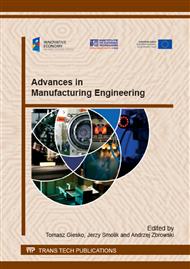p.238
p.246
p.255
p.264
p.272
p.283
p.291
p.299
p.308
Model of Intelligent Design and Optimisation of Structures of Vision Systems for Surface Inspection
Abstract:
The article presents a selected area of on-going research on the possibility of using intelligent computer-aided design systems for surface inspection of products manufactured in large batch processes. Systems based on machine vision are used wherever it is essential to obtain high efficiency, reproducibility, and where there is the need to use non-contact measurement methods. The IT solution significantly improves the design processes by automatically generating optimal configuration of machine vision systems intended for the detection of surface defects in manufactured products. General structure of the model and its individual modules, performing functions such as automatic component selection of machine vision systems, setting the angle of the light emission towards the surface of the analysed objects, and the selection of the range of light radiation are discussed. The individual configuration steps of vision systems for surface inspection, in which processes are implemented using expert systems making inferences based on both classical bivalent logic, as well as multi-valued fuzzy logic, are shown. The author presents the original methodology for the optimisation of structures forming vision systems intended for the reduction of components and costs associated with their implementation in physical structures, designed for use in production lines. The results of empirical studies of the calculation model are shown.
Info:
Periodical:
Pages:
272-282
Citation:
Online since:
November 2014
Authors:
Price:
Сopyright:
© 2015 Trans Tech Publications Ltd. All Rights Reserved
Share:
Citation:


